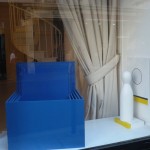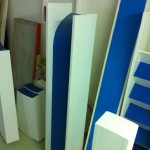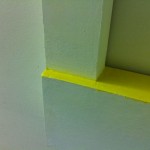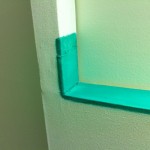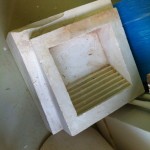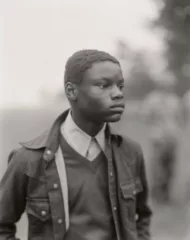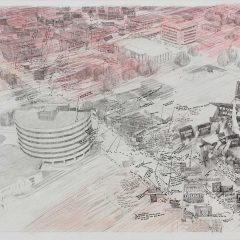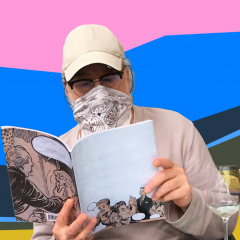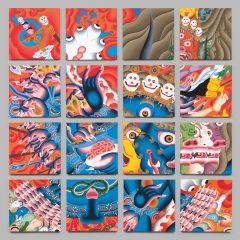The Italian artist Rupert Mair recently exhibited at the Pixie Gallery in Paris. His show was entitled “Enjeux”. It was a showcase of the delicate and seemingly tentative and yet it was affirmative in its silent insistence that there could be mass to nothingness. All you need is a hint. Many of the pieces assembled in the space resembled the parts of familiar games and yet neither the pieces nor the games they suggested became whole or playable.
His last show is the result of a choice he made more than ten years ago to no longer fill the entire pictorial plane with paint and to renounce all figuration. He now prefers to compose exhibitions with semi complete elements leading to a whole rather than necessarily making each element a work unto itself.
This tactic is clear when we visit the studio. No paintings are on display. The sculptures are pressed up against the wall ready to be deployed, or not. Mair seems happy to leave them be and to deploy them in his head. He pulls some out for me and kind of throws them out on the floor like carpets. He arranges them and then arranges them again. There is no set arrangement. The spectator can meddle there as well, I guess. But who would ever dare rearrange a show? Well actually there is Captain Culture & Herr Doktor Kropp, a team of art consultants who will fix your show free of charge, but that is another story.
Taken together Mair’s work has an IKEA quality to it — decoration that is derived from a furniture sensibility. You are always wondering about a work’s possible function.
The objects are more or less flat. Volume is derived by assembling flat elements. There is always a painted edge or plane somewhere that suggests an orientation. Paint is applied in strips in an allotted space. It doesn’t transfer, travel or overflow.
Color is emitted and diffused on neighboring elements of the painted plane. The color becomes lighting and the art/ furniture combination is fulfilled (but do not try to read by this light). According to Mair the color is a residue of a greater mass or color that was there before.
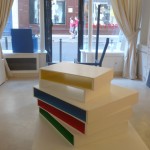
His works often suggest that they were once bigger but that a part was detached and dispersed.
Mair’s work is a little messy. Canvas and wood meet imperfectly in a jury rigged fashion, painted edges are vague and fuzzy. A straight line misses its mark . . . there is a fuzziness which avoids a conclusion. It is a controlled messiness which alleviates the seriousness that this work could deploy.
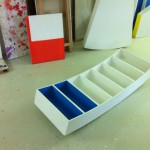
You are also free to turn his pictures this way and that (look above and below).
The tug in two opposing directions — that of painting and sculpture — that many artists have felt is at work in Mair as well.
In one work the frame slides out from behind the canvas. In another the two vertical elements of the frame rise like goal posts out of the top of the picture.
Mair uses canvas and stretcher structures as the building blocks for his objects. The canvas and chassis entente remains as a support and surface for the paint, but they have become objets d’art in their own right. This is a sly way of painting and sculpting.
The paint, however, cannot reciprocate. It is happy to lie ensconced in or on the object. It bends to the will of the canvas stretcher structure and from there it faintly diffuses itself onto the white planes of its keeper. Overall there is a persistent flatness which means that Mair is still mostly painting.
Mair’s studio is on the edge of a long straight canal typical of the landscapes of northern Europe with their straight lines and flat lands. I ask him if his proximity to this cityscape has influenced his work and he professes that the open space is a pleasure to be in but he cannot point to any work that might be a result of this landscape.
Although Mair’s work calls to mind many other artists he himself doesn’t work within those references. He is looking to make art that can still serve a purpose and open new perspectives. If he proposes a hint of utility it is in hopes that the spectator will go beyond that and confirm the object as art. Letting the spectator confer the status and value of the work is risky but honest.
There is a lunge towards the infinite here and it is achieved without a draughtman’s means. Mair has come far from the huis clos of the picture where all is controlled and described to a place where suggestion sets us in motion.
The bits and pieces add up to what most bodies of work are becoming: a set of pieces to a board game that are looking to be deployed on the great board of the contemporary art game.
However it seems that the more artists create the more fragmented art becomes. The number of pieces needed for the game is infinite and their signage forever evolving. There will always be missing pieces.
I like the line that Mair is pursuing. It is unhurried and consists of a few brush strokes and a few strokes of the saw combined with gravity’s will and a certain nonchalance. You can follow the signs or not.


